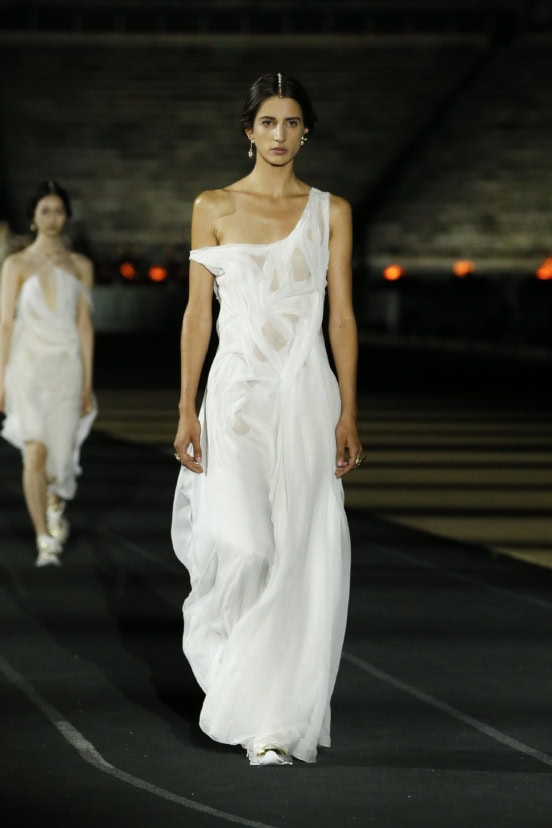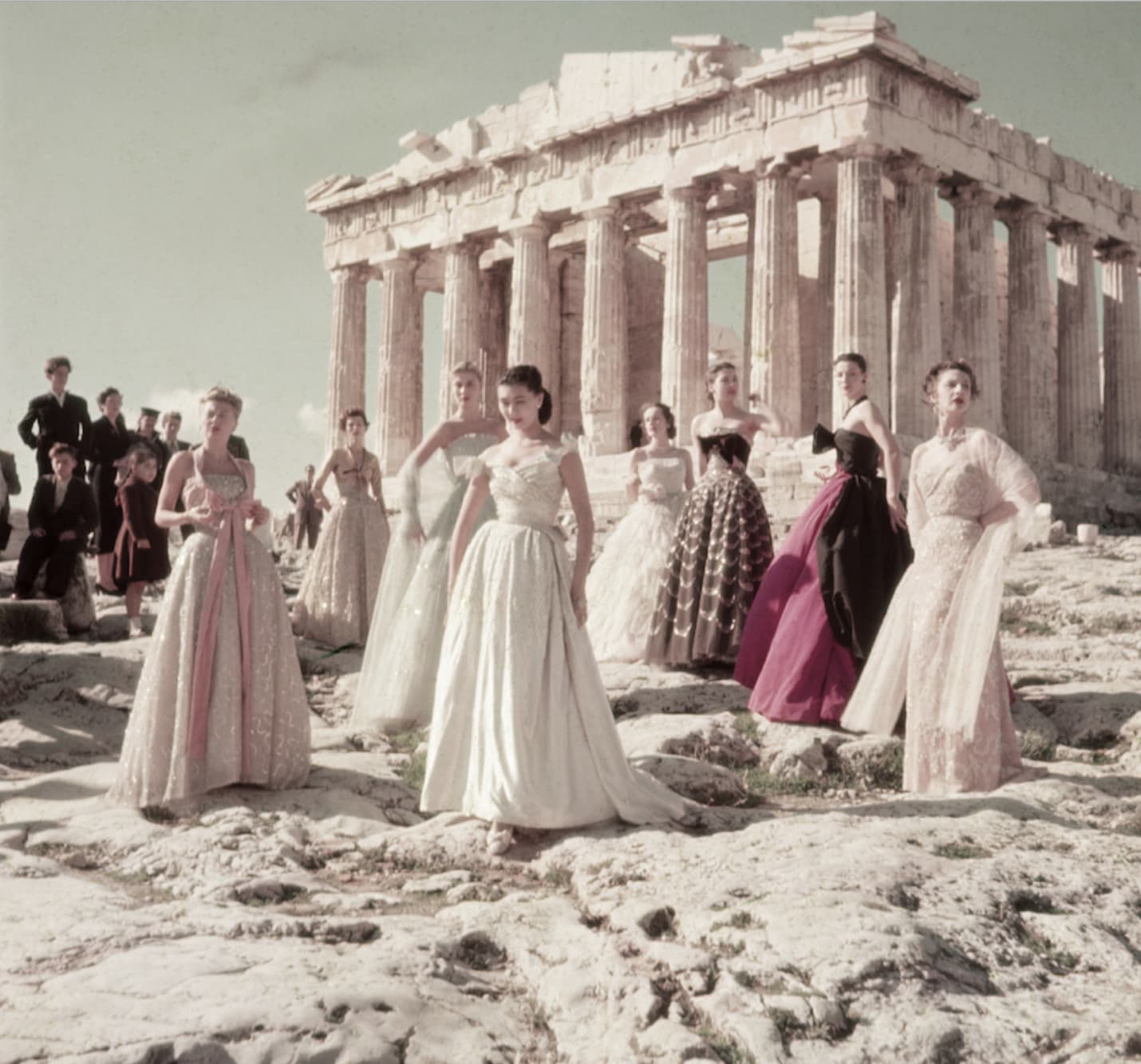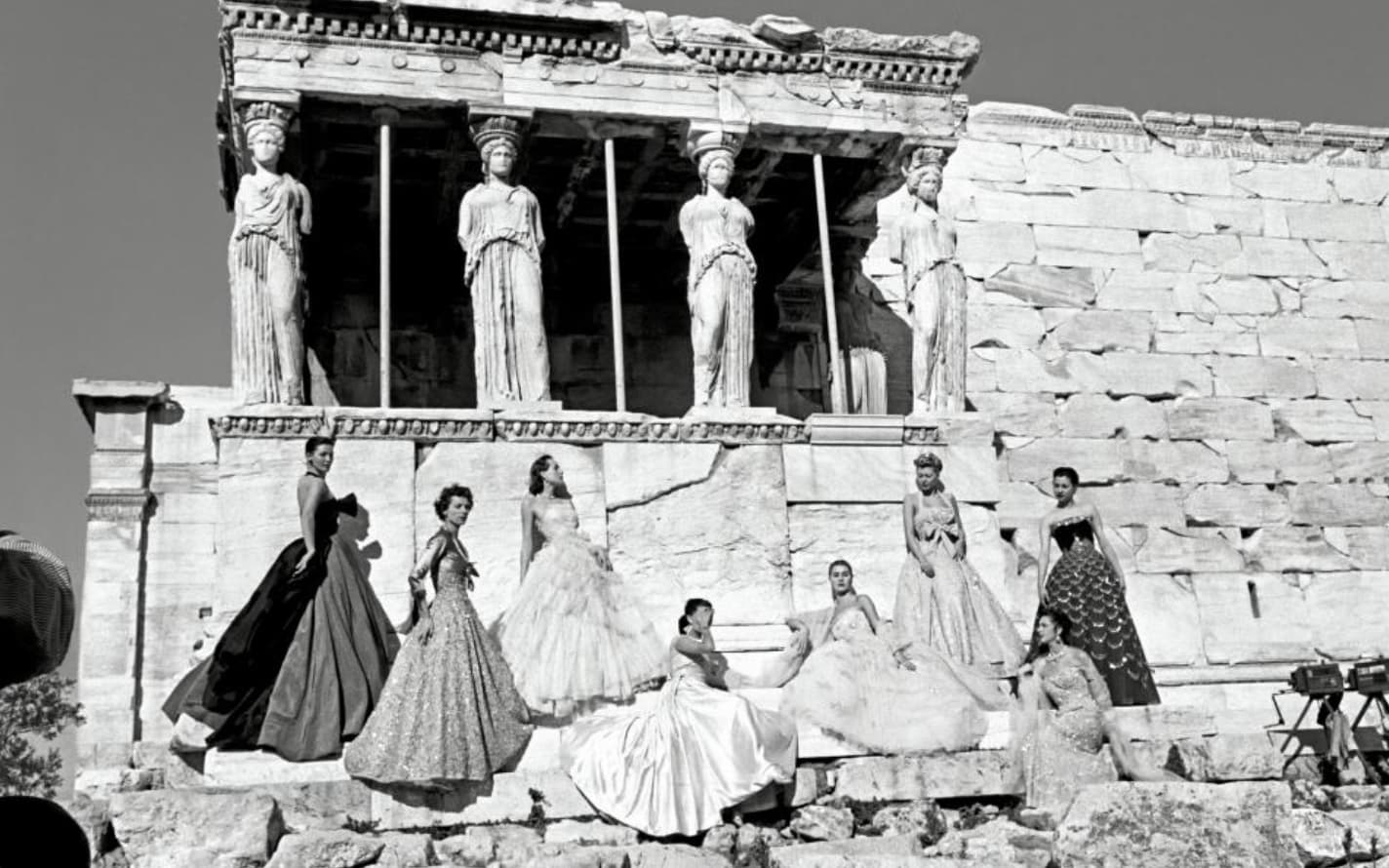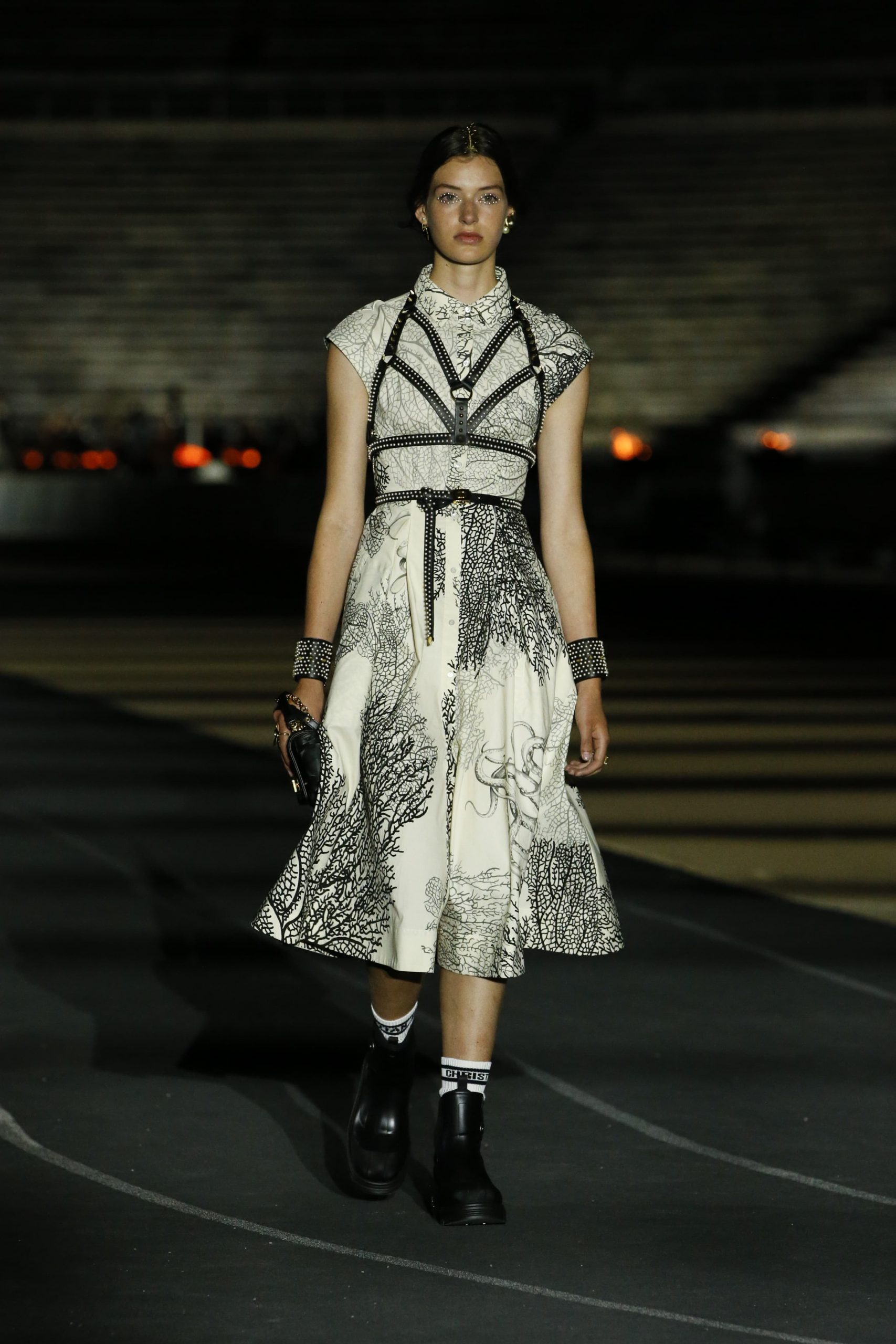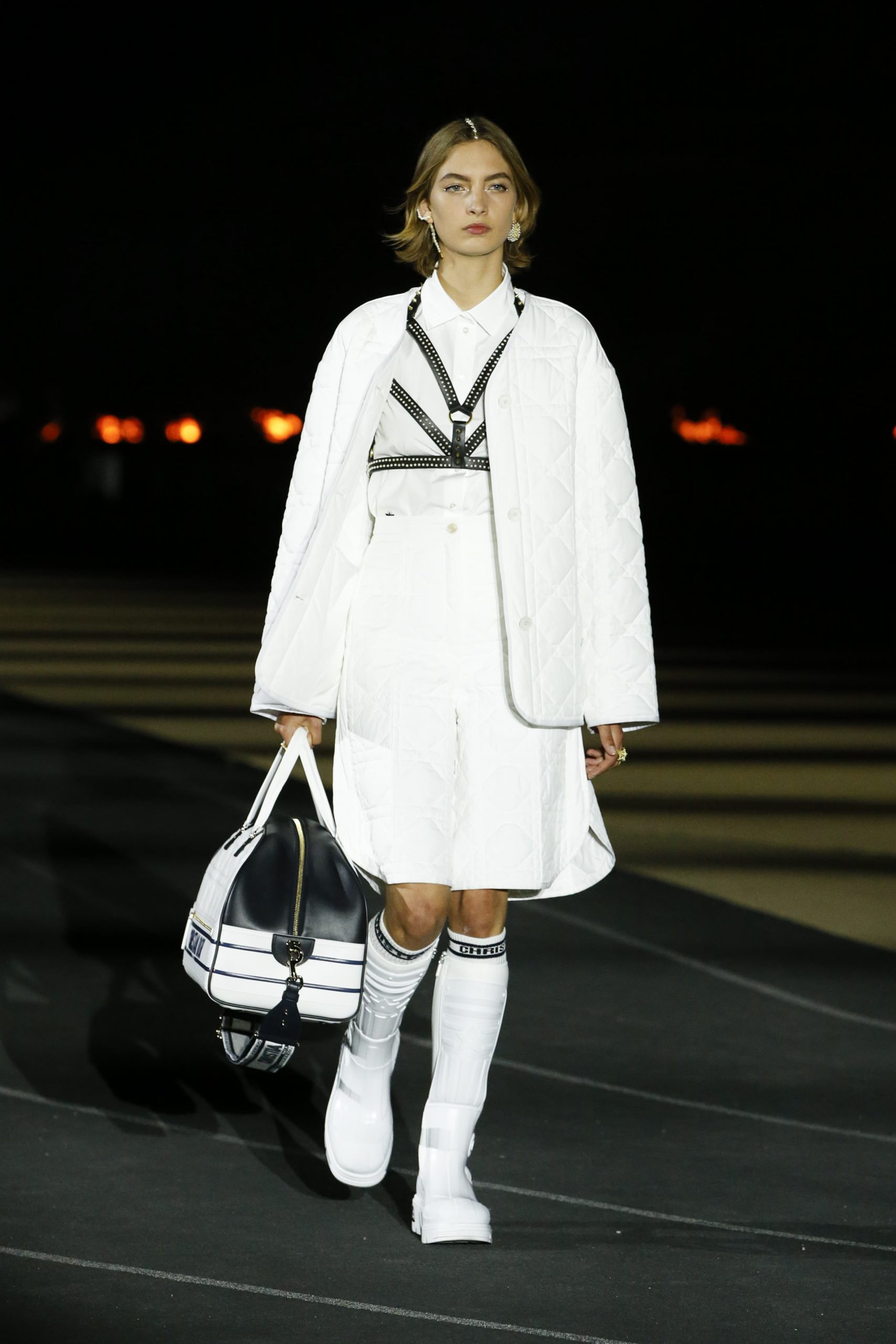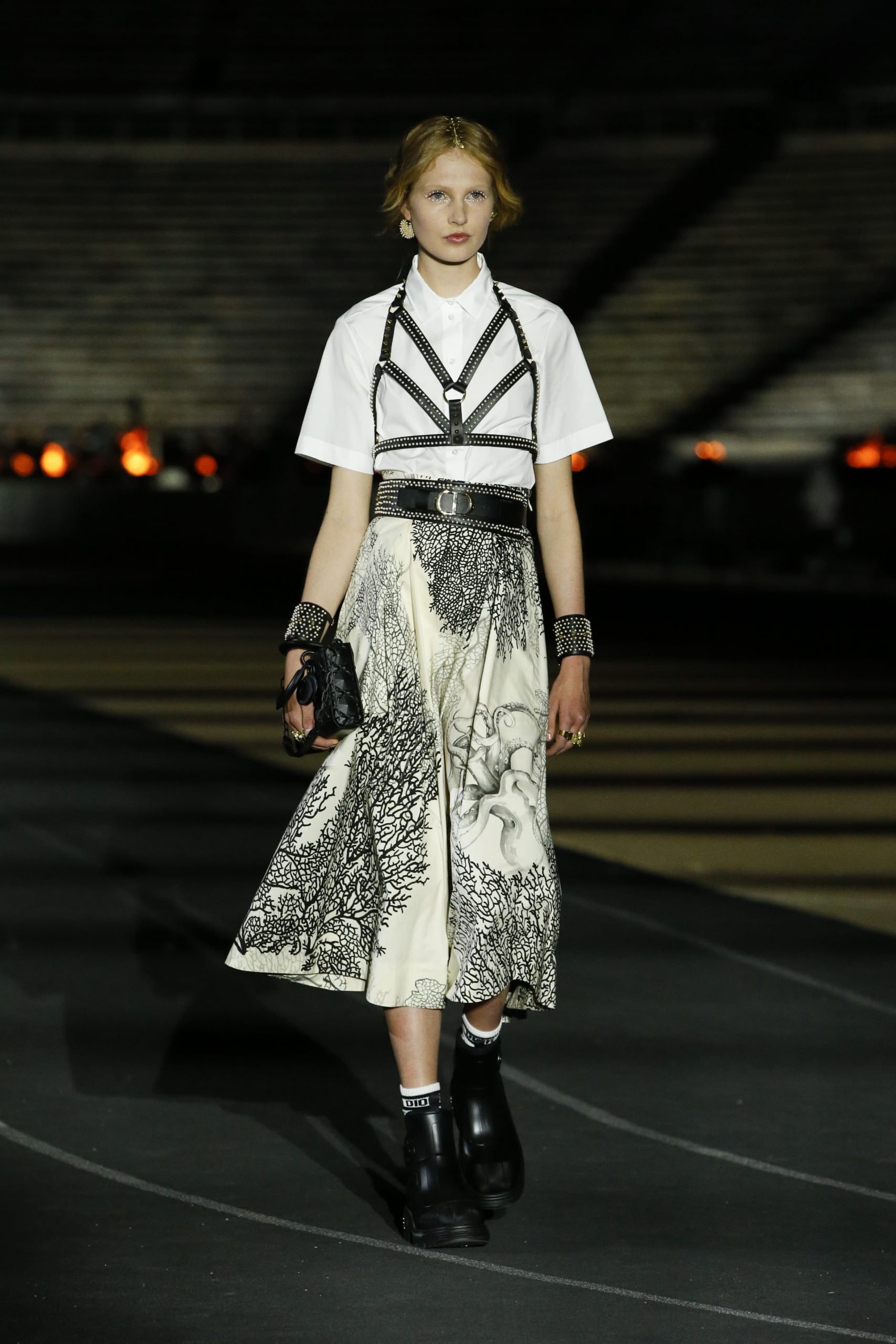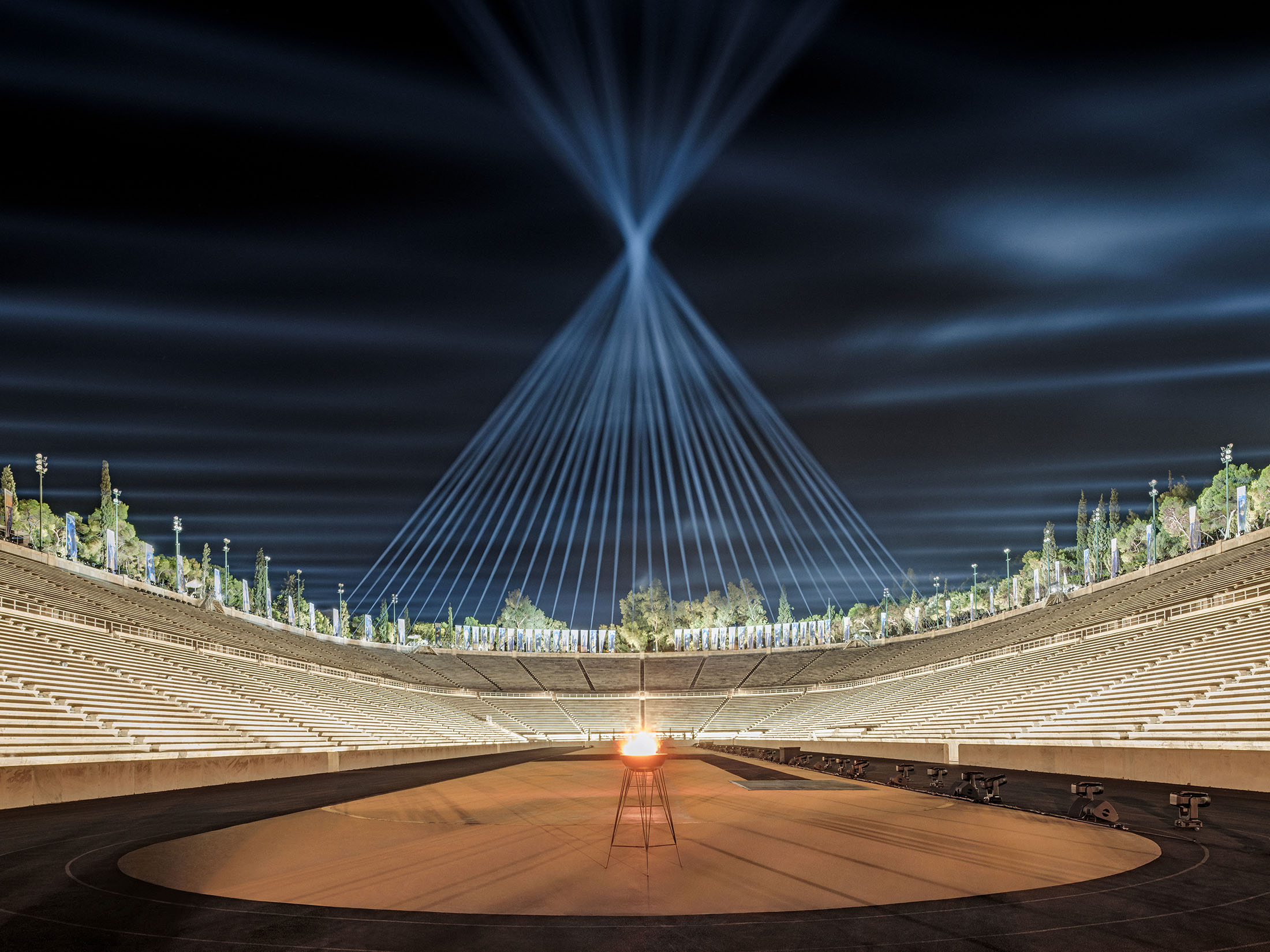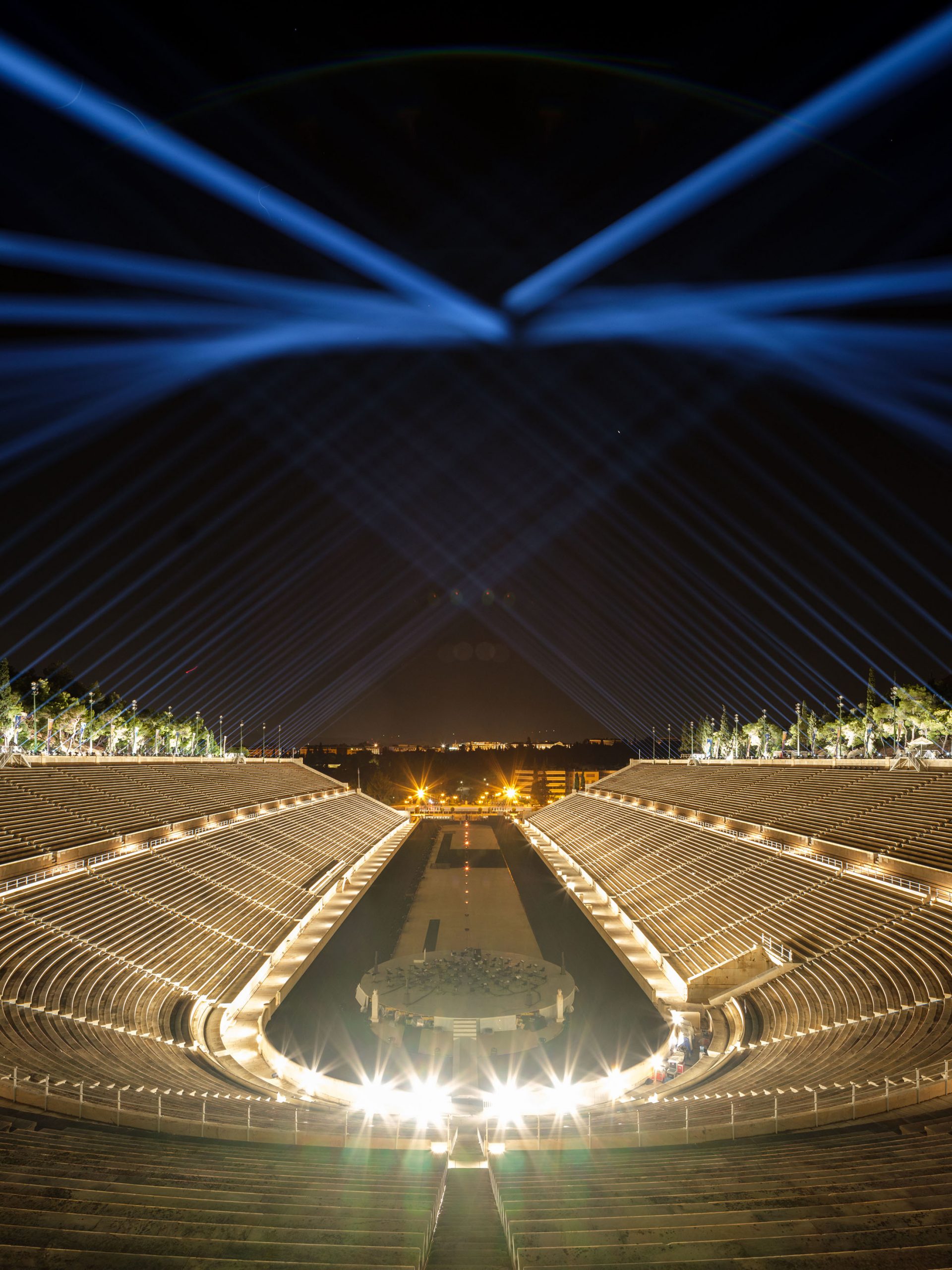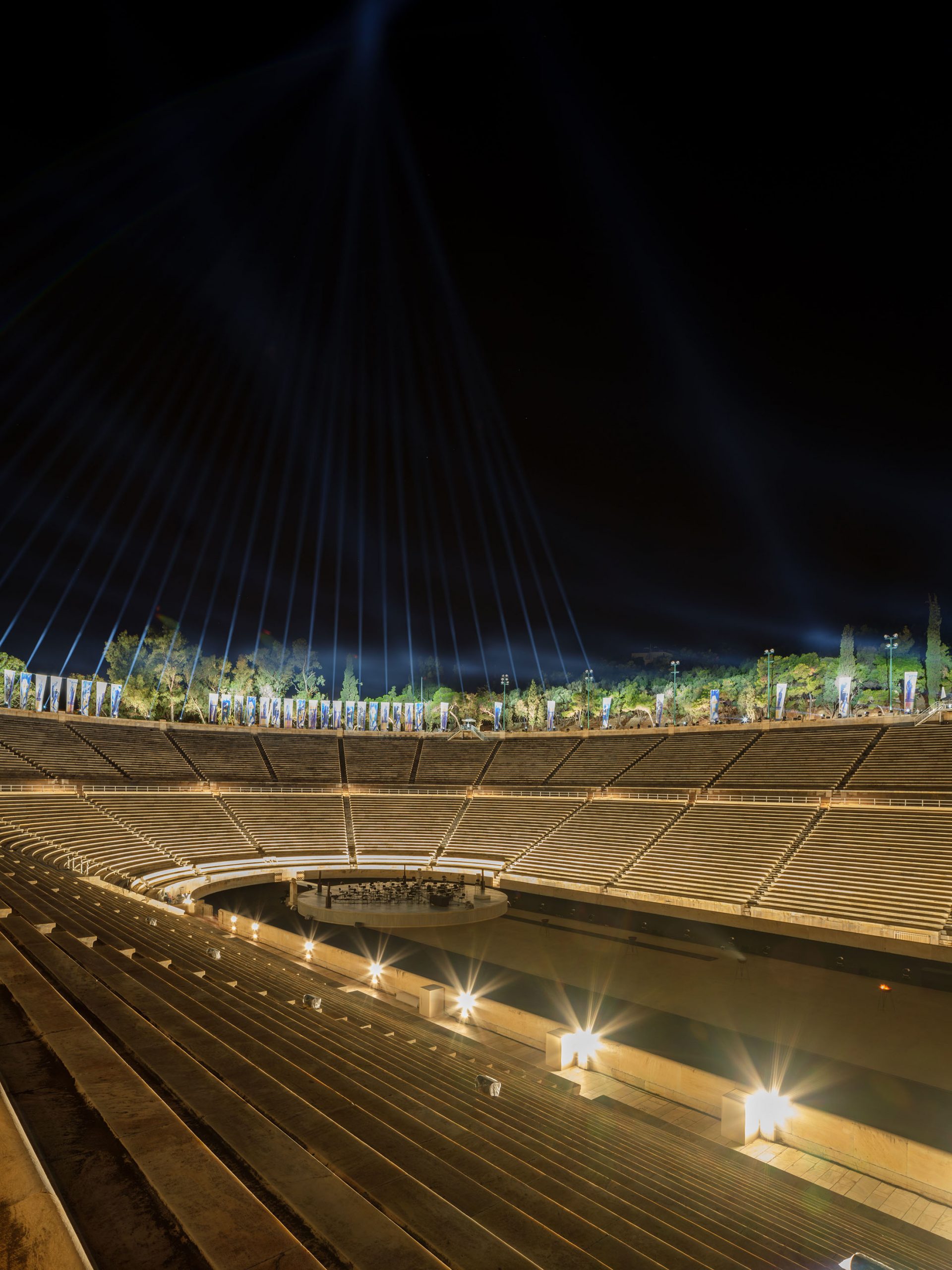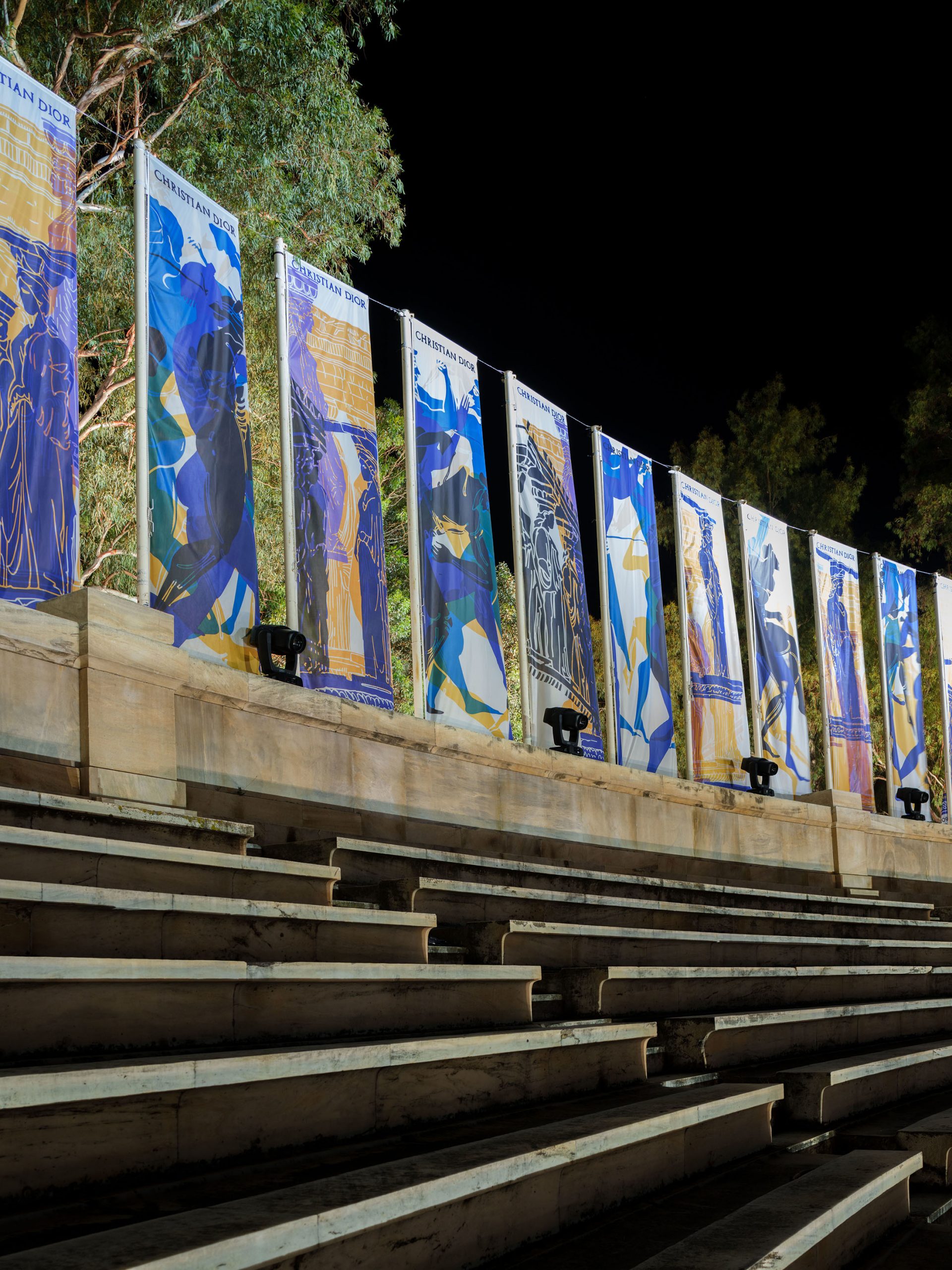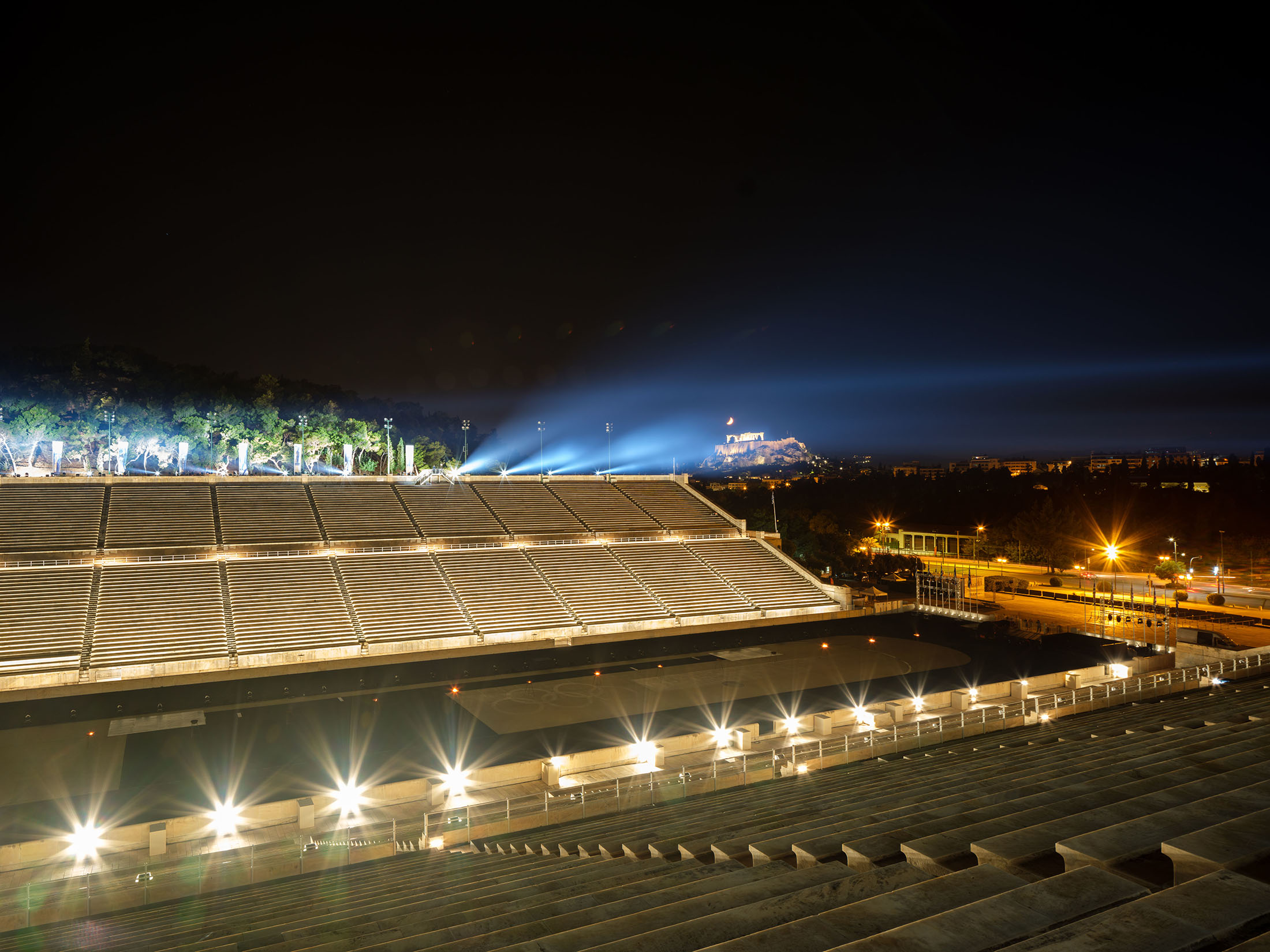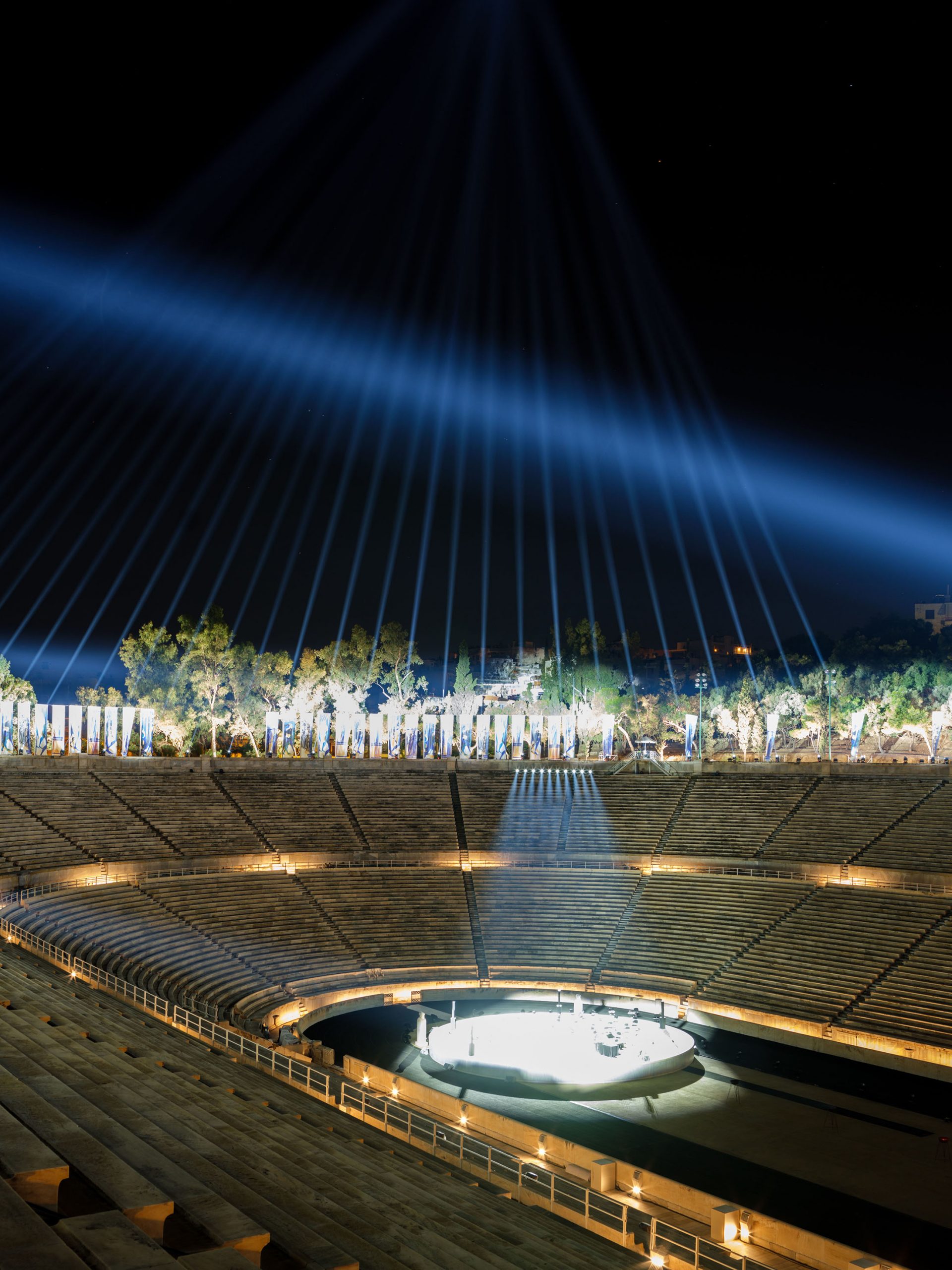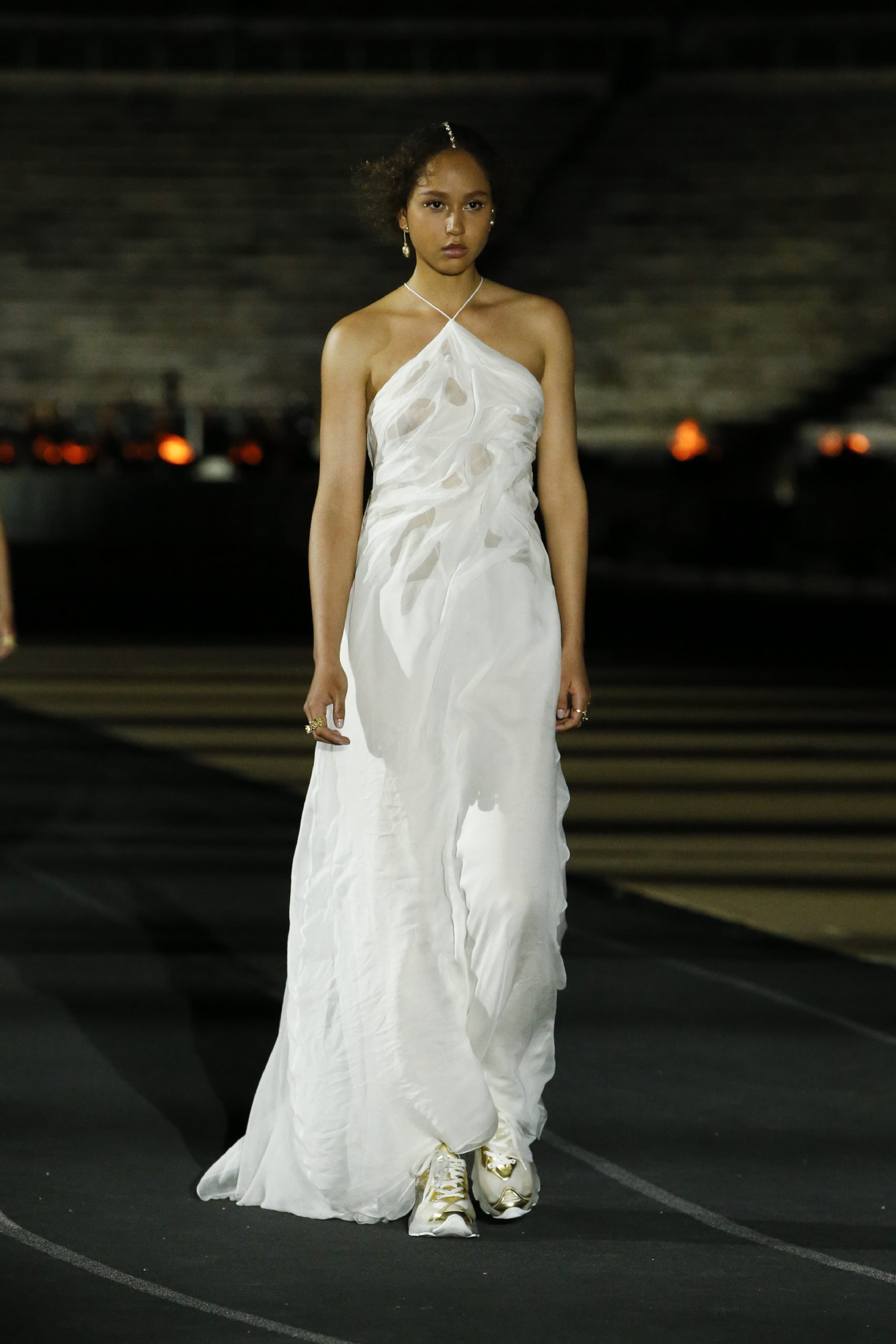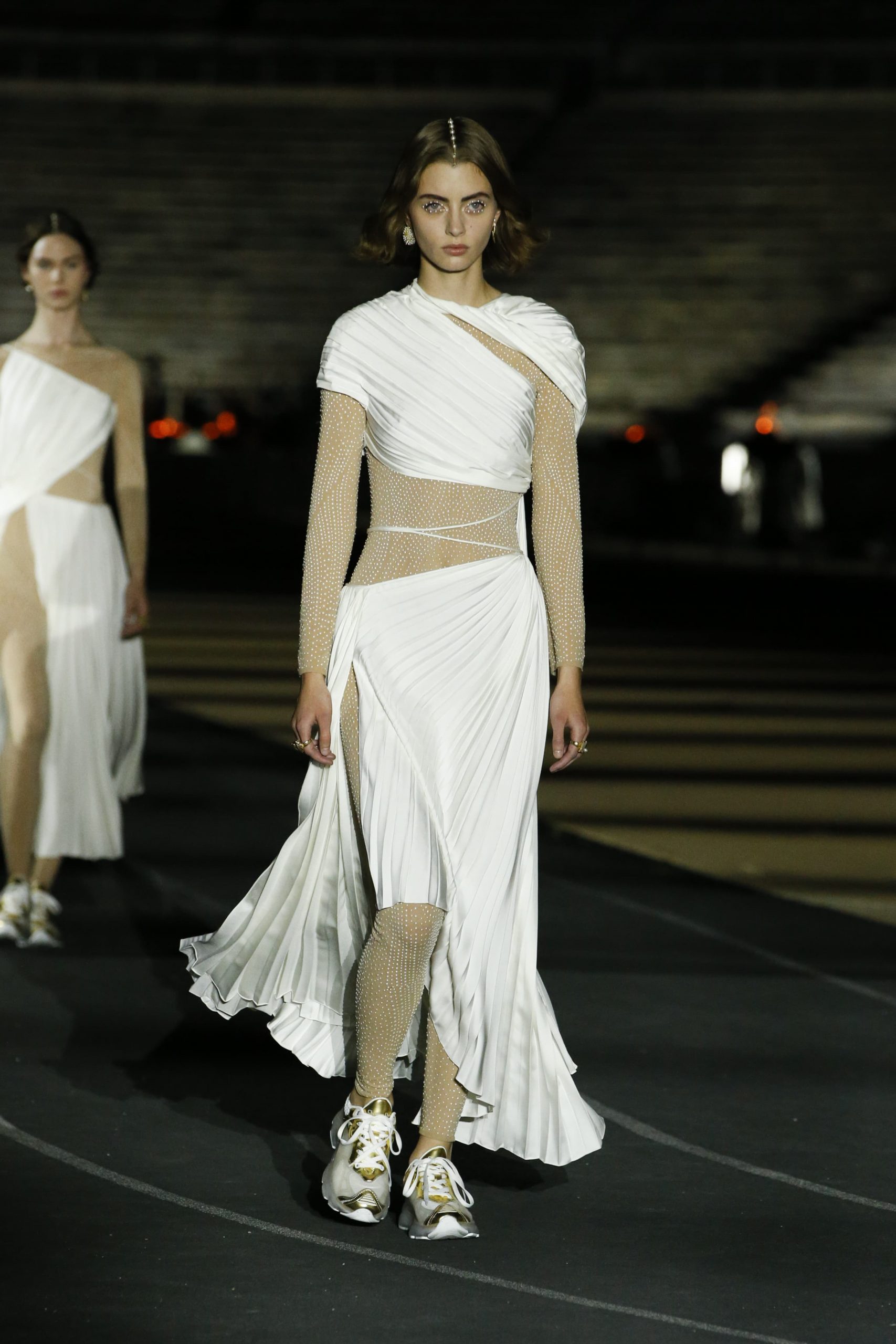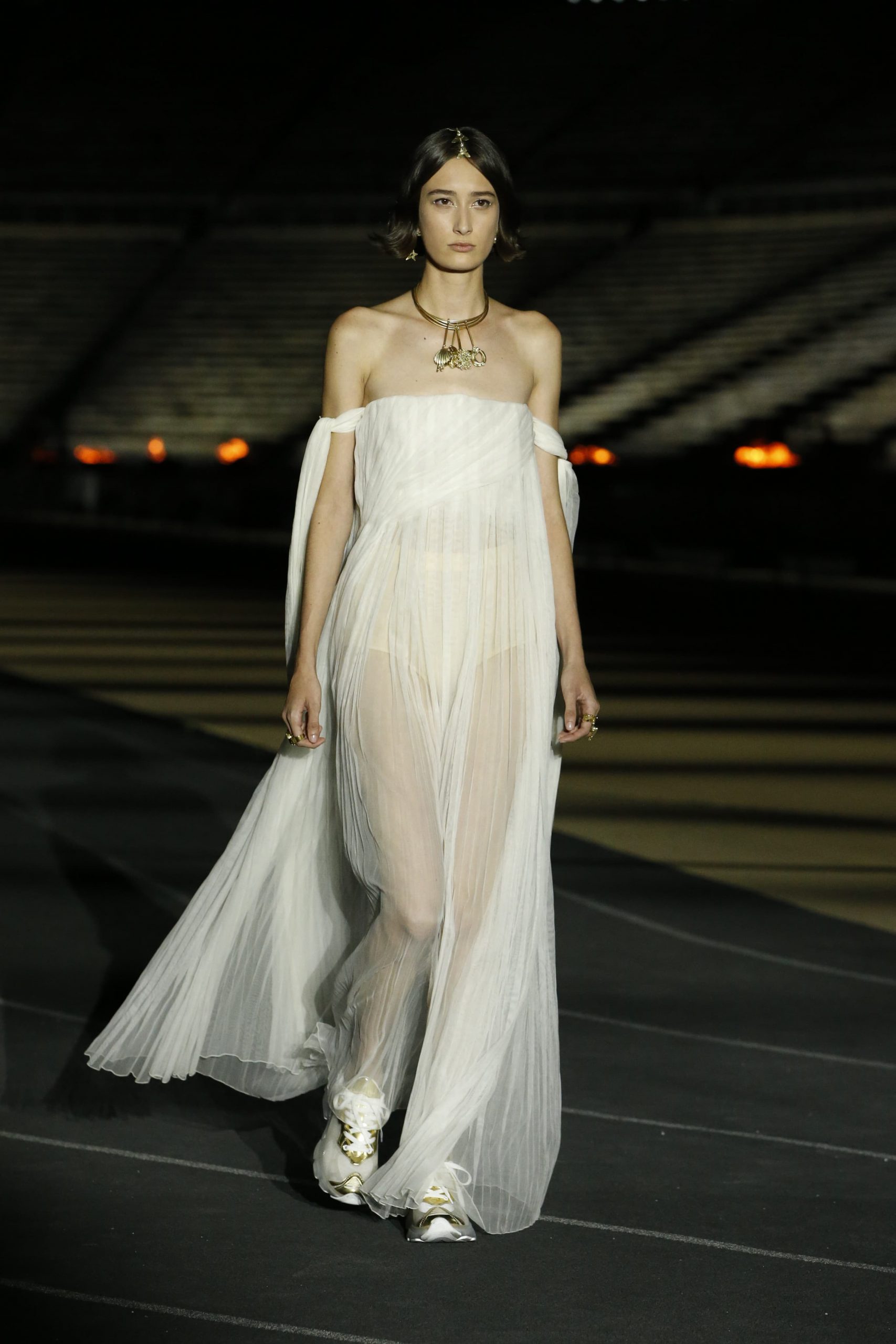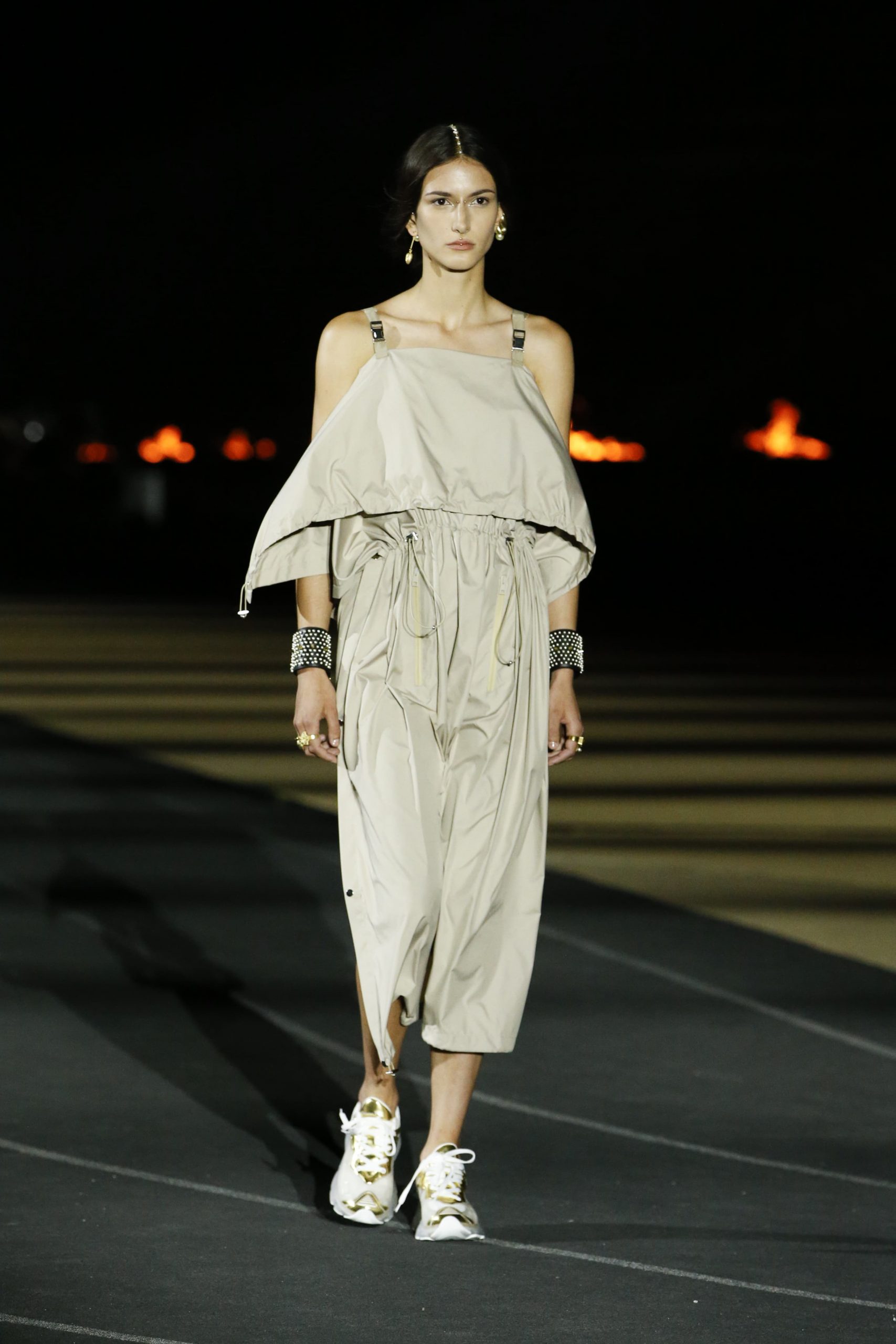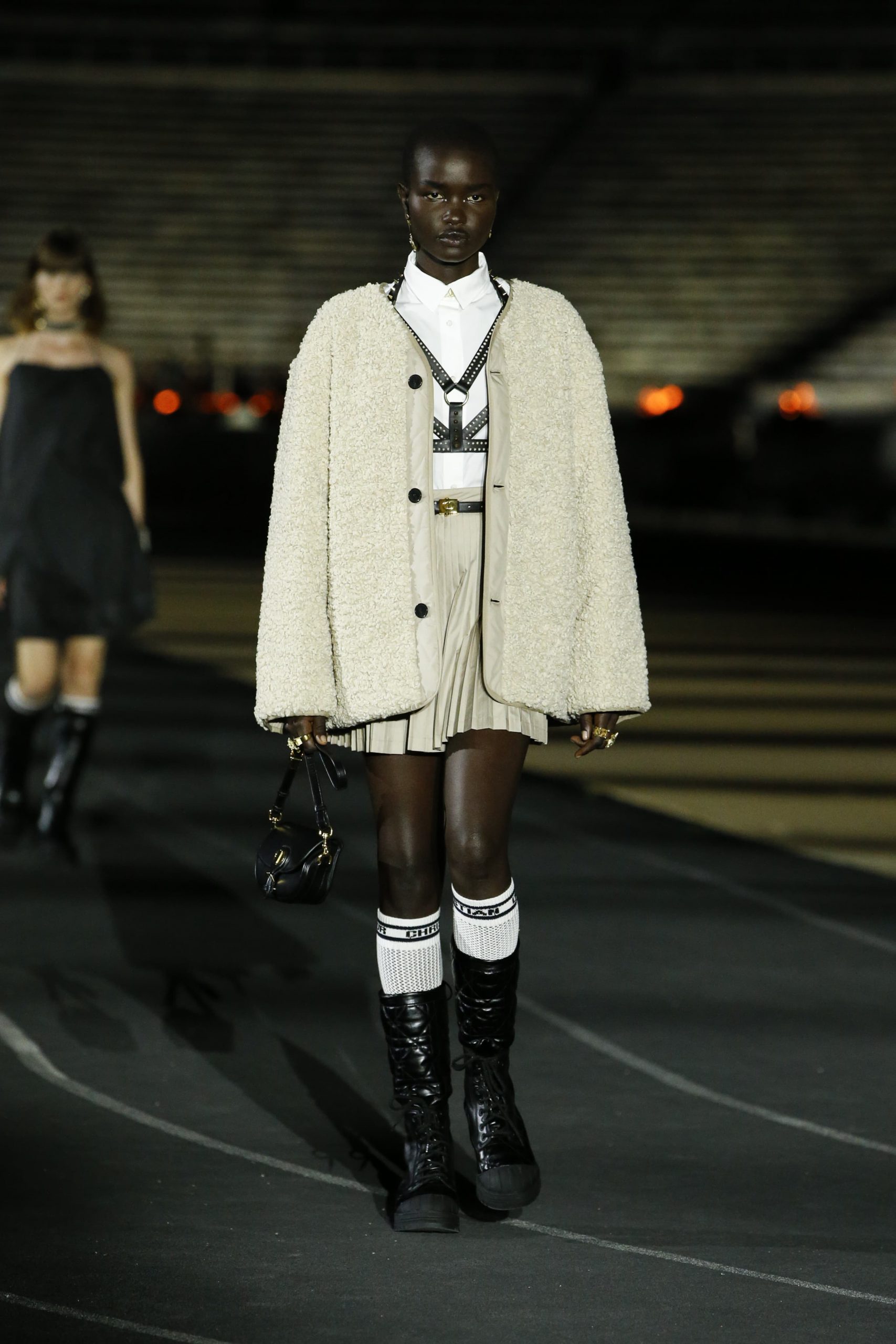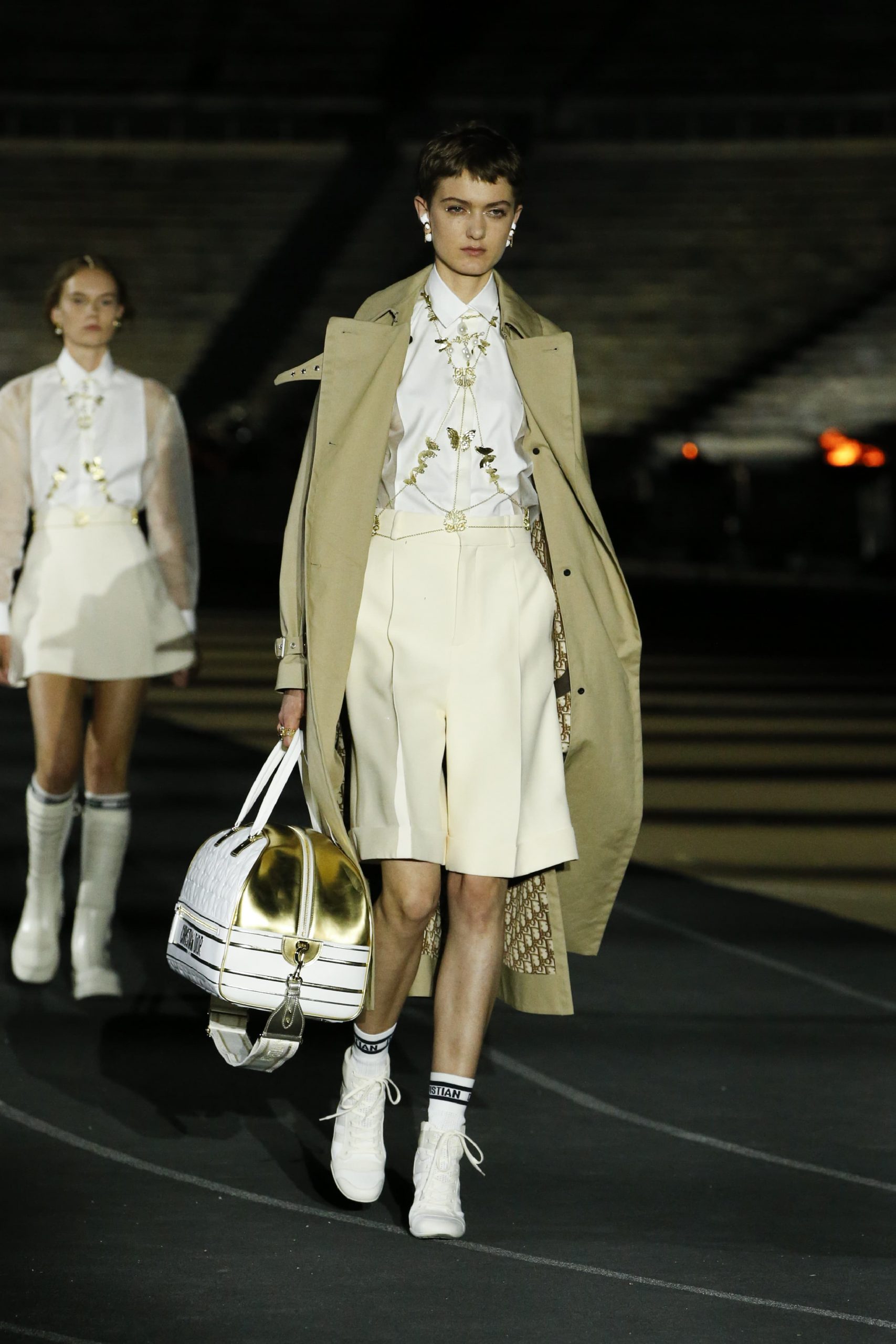Review of Dior Cruise 2022 Fashion Show
A Smorgasbord of Antiquity, Art, and Artisanship Filled A Stadium of Ease and Sporty Clothes
By Long Nguyen
In 1951, the Franco-Swiss journalist and photographer Jean Pierre Pedrazzini photographed eight models wearing Christian Dior Autumn-Winter 1950-1951 collection in the Erechtheion temple on the north side of the Acropolis with the Caryatids as a backdrop for the magazine Paris Match.
Maria Grazia Chiuri’s choice of these Paris Match photographs depicting the clothes from the Autumn-Winter 1951 collection as a departure point for this cruise show wasn’t a surprise given the propensity in this cruise show towards the sleek sportswear feels permeating throughout the entire collection. The designer made these clothes as light and as airy as possible to enhance the freedom of movements essential in sports.
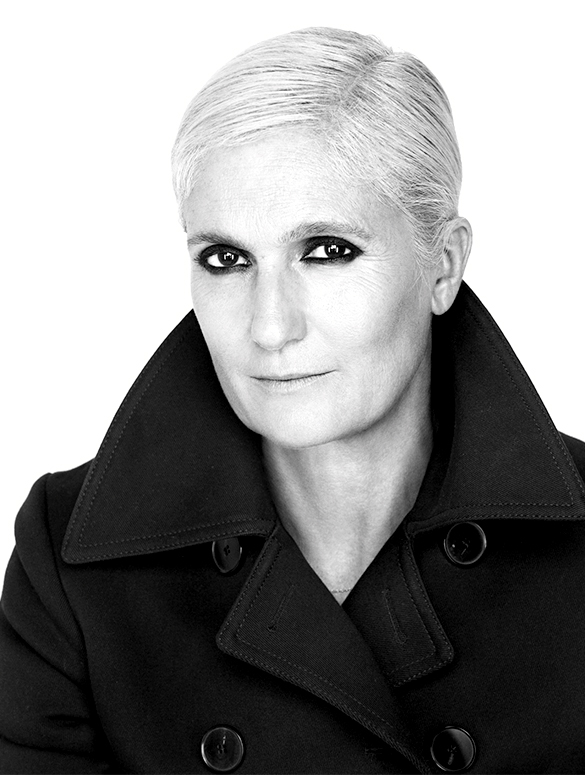
I don’t think it’s just a matter of silhouette. The images of the great photographer Jean-Pierre Pedrazzini for “Paris Match” document a return to the origins of beauty, a reflection on perceptions, proportions, on harmony that only the encounter between the body and draped fabric generates. It seems very interesting to me today to recover an experience that defines a specific moment in the Dior heritage and to translate it into the House’s present. It is a way to take disparate fragments, piece them together, and understand the cultural value of each clothing choice. And I think that this looking to the future with an eye on the past is reflective of the way I design.
– Maria Grazia Chiuri, via Zoom in explaining the meaning of her choice of these photos from 1951
Christian Dior’s Spring-Summer 1951 ‘Ovale’ collection featured less volume with pleating work creating the oval shapes that focused the body’s natural lines. It was the beginning of a departure from his established ‘New Look’ with the famed nipped waistlines and generous proportion skirts into clothes based more on sharp geometric lines. The Autumn-Winter 1951-1952 ‘Ligne Longue’ collection, in the Paris Match feature, offered in contrast with the lengthened and much narrower silhouette.
Photos | Jean-Pierre Pedrazzini/Paris Match
When the creative director spoke last September from Paris about the Spring 2021 collection that emphasized less of the couture constructions, Chiuri mentioned creating a new Dior silhouette, one with less focus on the famed tailored nipped waist silhouettes. Then, the designer took a drawing of the Diopaletot jacket for the Autumn-Winter 1957 made for a special unveiling in Japan at the time. The Dior Palto jacket was slightly loose with versatile closure – belted or knotted – set the tone for clothes a year ago freer from restrictive sculptural volumes.
Staged at the Panathenaic Stadium in Athens, Chiuri’s models strolled in the darkness just after sunset, lighted by bright white spots in a collection of looser shapes and sportswear clothes led by the opening look of a light tan cotton strappy jumpsuit with drawstrings waistband. A white loose-fitted Bar pantsuit followed, outlining the contrast and the mix of the couture-sport axis.
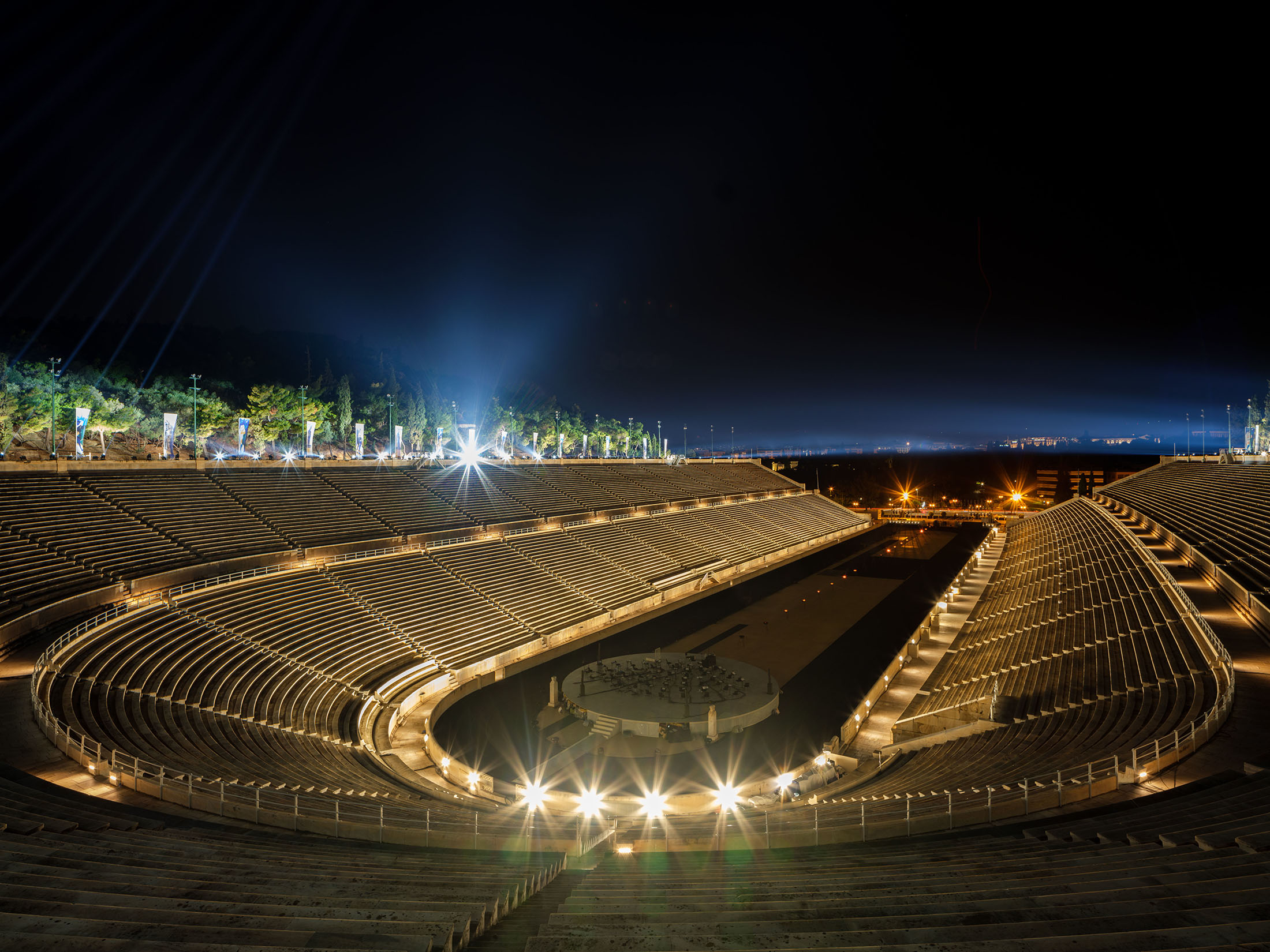
The unconstructed white single breast jacket paired with matching knee-length running shorts or a white silk asymmetrical one-sleeve dress are the types of clothes deliberately built away from the body. Instead, models wore them with white leather sneakers or knee-high boots instead of athletes in their high-tech sports gears on the running tracks. Herbert List 1930s black and white photographs, taken in Greece, inspired these white dresses.
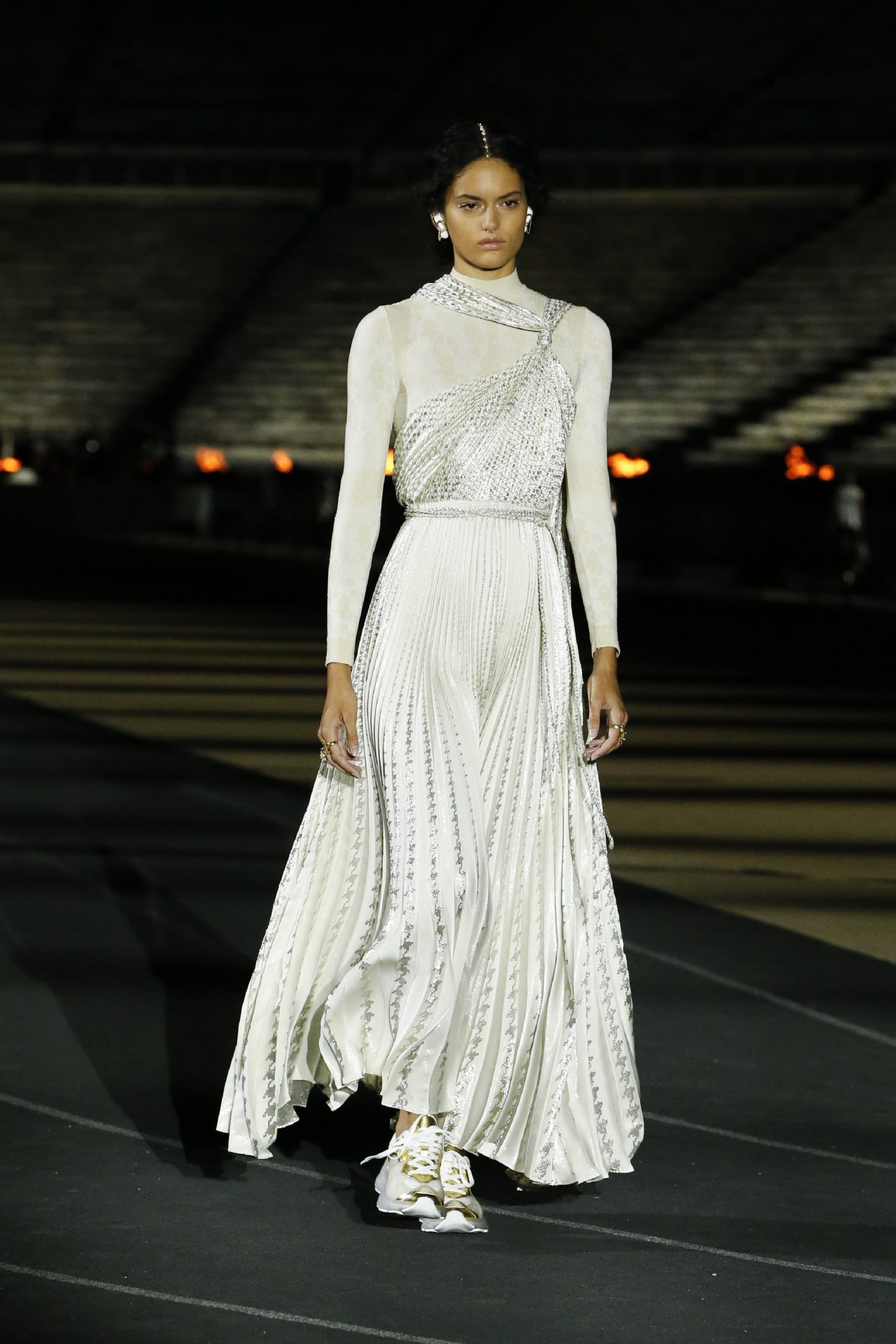
In the Hellenist classical era, the peplum was a long tube of fabric draped and tied at the waist, creating a fold of fabric on the upper body and cinch for the peplum shape and volume. Here, in these Dior versions for 2022, the Grecian dresses are soft, even sporty, with a silver one-shoulder strap dress worn over a white tee shirt. The mixture of open and close peplos results in the white pleated asymmetrical fold strappy dress, all worn with a sheer tulle light embroidered tee-shirt underneath.
Mixing in between these more polished couture clothes are vibrant blueprint sweats and parkas. A future bestseller will be the blue Dior logo crop vest, logo tee short, matching logo short, and logo leggings. Oh and surely these new sneakers.
The black leather corset vest, white shirt, and long shorts recalled the fencing looks that Chiuri sent out in Paris for her debut Dior show for Spring 2017. The draping and tying of the white, the light green embroidered or the silver pleated cowl neck, or strapless white Grecian chiffon dress with gold belts reminisced the Spring 2020 haute couture show. But, then, these ancient Greek peploi find new life than shown inside the art piece created by Judy Chicago, and now, on the black running track of the Panathenaic Stadium.
Built initially with marble as a racetrack by the Athenian statesman Lykourgos around 330 B.C. primarily for the Panathenaic Games and enlarged in 144 A.D. by the Athenian senator Herodes Atticus to a 50,000 seats capacity venue, the Panathenaic Stadium hosted the Olympics Games of the modern era in 1896 and again 2004.
For this cruise show, the artist and creative designer Alexandre de Betak transformed the stadium into a majestic nighttime extravaganza spectacle site. Soft lighting around the seating area and a straight line row of wood-burning bonfire down the middle of the stadium ended at the oval shape stage where the 55 member band played live music. The runway ran more than 500 meters long as a black running track with 400 lights, 20 braziers, and flags at the top of the stadium.
Under Chiuri’s stewardship, art and artists are integral to any Dior collections.
I think it is a way to remember that fashion and the arts are distinct disciplines but that they share and define a common horizon, that of contemporary visual culture. I believe it offers a way to constantly redefine standards of beauty, and to set reflections on today and on our identities, through practices ranging from traditional craftsmanship to the more abstract forms associated with the visual arts.
– Maria Grazia Chiuri, on how art and fashion are always interrelated
Chiuri said of how art and fashion are always interrelated.
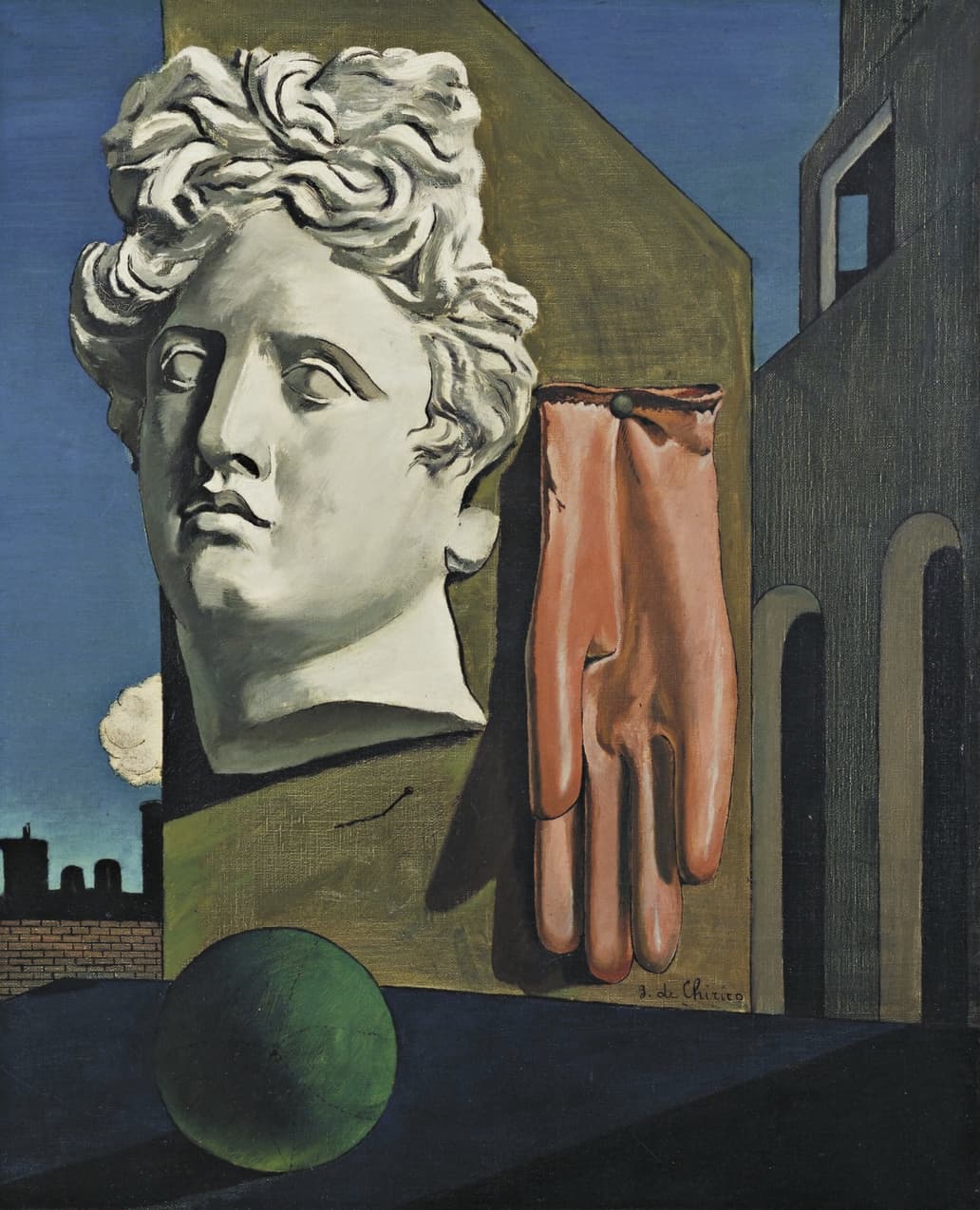
Nelson A. Rockefeller Bequest. Courtesy MoMA, New York
Giorgio di Chirico deliberately placed objects within a painting with no relationship to each other in real life. For example, in one of the artist’s known paintings – 1914 The Song of Love – he combined an orange surgical glove, a Greek white marble head, a green stone ball, and parts of the Coliseum. Chiuri chose this Greek-born Italian artist and writer for his masterful blending of unrelated things, altering reality and surrealism by alluding to hidden meaning beyond the immediacy of apparent appearances.
The Berlin collective Honey Suckle Company created a montage juxtaposing images of art and fashion blended with music by the Greek musician and artist Eleni Poulou. These short video teasers took di Chirico’s heterogeneous paintings into the contemporary social media-friendly platform, displaying clothes mixing couture, athleticism, and antiquity dress, setting the atmosphere for the actual show. The singer Greek-American Ionna Gika performed live for the show in white tulle and lace leather-tiered sheer dress over a white bodysuit and a black chest belt.
The Italian artist Pietro Ruffo created sketches of these body silhouettes in blue patterns on pants and sweat jackets. Iolas was a pioneer promoter in modern art, giving the American artist Andy Warhol his first gallery show and the last major commission based on Leonardo da Vinci’s The Last Supper.
He took inspiration from the collection of Hellenist vases decorated with drawn bodies of athletes of the era once owned by Alexander Iolas, the global gallery owner and collector, at his home in Athens in the suburb of Agia Paraskevi (Villa Iolas). The silhouettes of the ancient athlete bodies grace the print on a white pullover anorak.
Ruffo has collaborated with Dior on many of the previous collections, including painting the fresco for the fall-winter 2017 haute couture stage as a star-shaped amphitheater overhead cover and recreating the tarot cards the Spring 2021 haute couture film.
The house’s history and the histories of Greek family artisans, together weaving a new record in the traditional Greek silks using a jacquard loom destined for younger women worldwide.
The Greek tailor and embroiderer Aristeidis Tzonevrakis from the Peloponnese region in southern Greece embroidered a classic white Bar shirt collar jacket with a pleated skirt and the book tote. Silk Line, a factory in Soufli known for its silk industries in the Thace region, wove the stripes and houndstooth using old techniques to make the white and blue stripe double breast crop jacket with cuffed wide-leg pants. The Athenian Atelier Tsalavoutas made the iconic fisherman cap combining ancient and new technology with the cap with a braid made by NE.M.A, the atelier dedicated to preserving passementerie techniques worn in the show with a nautical stripe jacket and navy pants. The Greek artist Christiana Soulou drew female mythological figures made into jacquard in the folds of the dresses.
Today, building a community is essential and critical for fashion. Investing in local culture and local manufacturing is an intelligent initiative for a global brand. Dior cruise’s collections under Chiuri have been a pioneer in this engagement to highlight traditional and local artisanal methods from Southern California to Southern Italy and now Greece.
It isn’t just reconnecting different cultures from ancient Greek to the traditions in art and in a fashion that still survive today. Instead, it relinks the history and heritage of Dior, transposing memories from a distant era to the rapid-paced digital world. The primary intention is to envelop the present by transporting a moment in Dior’s fashion past capture in photographs seventy years ago into Dior in 2021. Thus, the house’s history is transmitted for the younger generations, not as disposed to historical learning.
But, catering to the younger audience means adopting the kinds of habits of these kids. In this respect, how a significant heritage brand like Dior continues its reinvention each season to satisfy the hordes populating all over social media seeking the types of relevance usually not equated to brand heritage or history. How then to engage this fast-paced generation without being pedagogic?
Chiuri’s answers are to approach the actual clothes by emphasizing their easiness in terms of the looser shapes and adamant in the connections to Dior’s history.
Yet, these light, airy and movements o cruise clothes that denote a sense of a sure celebration of freedom seem that Chiuri is still working within the confines of history, of having to equate her strong work constantly injecting a bit of the past. As the title of the photo book – Her Dior – composing images from leading women photographers shooting the different collections that Dior released in March with Rizzoli spell out succinctly, it is her Dior now. In this literal sense, this collection affirms another step towards this independence.
Does the targeted young generation even worry about heritage anymore, however lofty the goals are to preserve and enhance history, or do they see the clothes, sneakers, and bags as presented are right for them?
A case in point is that the Dior Men x Sacai image dropped less than a week ago for merchandise available this November. The capsule indeed has the Sacai design signature where Chitose Abe, the founding designer, has perfected her vocabulary of hybridization since launching her label in Tokyo in 1999. The clothes feel more Sacai than Dior Men, save perhaps for the floral imprint on a loose ecru jumper-sweat top paired with short loose work pants. The intended audience for this drop cared for is the look of the merchandise and how they can incorporate these looks Dior Men x Sacai merchandise into their routines. Less of primary concern is the historical heritage of Dior and Sacai inherent in these merchandise.
Rather than the preponderance of heritage in choosing the right garments and accessories, it is the familiar visual style shared by the youths’ respective communities that may matter a great deal.
The show could benefit from slight editing of the looks shown. However, given the superb and giant location, the many outfits shown were perhaps a necessity.
